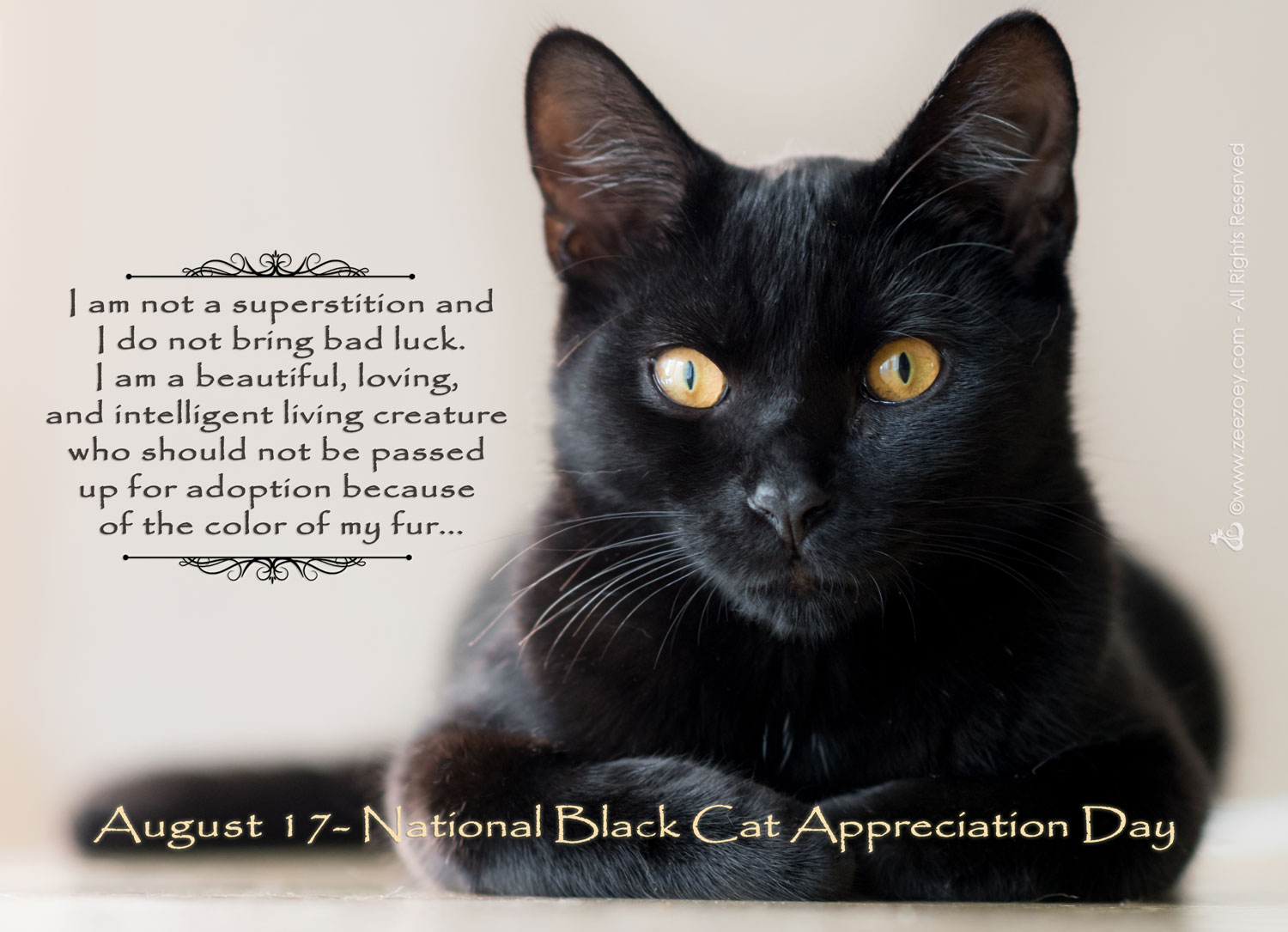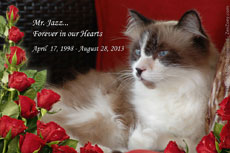Why Black Cats Have Black Fur and How to Take Great Photos of Them for National Black Cat Appreciation Day
 Today is National Black Cat Appreciation Day and being blessed with a mini-panther in my life, our handsome rescue, Shadow, I know just how special these beautiful cats are. But, beautiful as they are, black cats are still considered by many to bring bad luck, simply because of the color of their fur. Those of us with black cats in our lives know we are the lucky ones to have them and in honor of the day, I thought I’d share some facts on what makes a black cat, black as well as some tips on how to take stunning photos of them.
Today is National Black Cat Appreciation Day and being blessed with a mini-panther in my life, our handsome rescue, Shadow, I know just how special these beautiful cats are. But, beautiful as they are, black cats are still considered by many to bring bad luck, simply because of the color of their fur. Those of us with black cats in our lives know we are the lucky ones to have them and in honor of the day, I thought I’d share some facts on what makes a black cat, black as well as some tips on how to take stunning photos of them.
To begin, interestingly, black cats are not a breed. From rescues to purebred to long-haired, short-haired, and more – there are endless types of black cats and it’s all due to science, genetics, and DNA.
Cats may be felines, but it begins with the birds and the bees. When two cats mate and produce a litter of kittens, each kitten receives half of his genetic makeup in the form of chromosomes – two pairs from each parent. These genes determine your kitty’s temperament, coat color, coat length, eye color, and other physical characteristics. Called an allele, for black it’s known as B and for a cat to be a true, solid black cat, both of its parents need to have the B gene.
There are three basic gene combinations that govern a cat’s traits, determining how much black, or what color combinations. According to an article in Basepaws, “Cat Coat Genetics,” they are “BB” meaning two dominant genes, “Bb” meaning a dominant and recessive gene, and “bb” meaning two recessive genes. Brown, chocolate, cinnamon, and similar coat colors are products of the feline primary gene for coat color (B/b/b1) and the intensity and pattern of these colors depend on the other genes involved in formulating the final feline phenotype.
Tabby is also a common color pattern (mackerel, classic, spotted, or ticked) and black cats can be tabbies in disguise. The tabby pattern is typically distinguished by bands of different colors and is the result of the dominant allele of the agouti gene (A). Thus, for a cat to be solid black, it must also carry a recessive gene known as a non-agouti (a), so that the tabby pattern doesn’t appear. Cats who have the dominant agouti gene will retain the tabby pattern and if a cat has the black allele, but the expression of the tabby gene isn’t completely repressed, ghostly tabby stripes could be faintly visible on the tail or legs, or the classic “M” pattern on the head, especially if the cat is sitting in bright sunlight.
According to JaneA Kelley, in an article for Catster magazine, a black cat’s fur can even be rusty colored. This is due to heavy exposure to the sun, or possibly from a deficiency in an enzyme called tyrosine which is necessary for the creation of eumelanin, the pigment that makes your cat’s fur black. And even like humans, as black cats age, they can go grey.
So, now we know what makes a black cat, black, but what about taking pictures of these gorgeous beauties so we can share our appreciation with others in photos? Because honestly, as beautiful as they are, black cats are notoriously difficult to photograph, with their lustrous, shimming coat often turning into a dark loaf of cat bread in your pictures. Here are 3 quick and easy tips that require nothing more than a simple Smartphone (and maybe a little bit of patience!)
![]()
FOCUS ON THE EYES: For a black cat, the eyes might be the only pop of color they can offer in a photo, so take the time to make sure you are featuring them at their best — in focus, expressive, and properly exposed. If the kitty won’t cooperate, wave a feather toy above your camera to get their attention so they’ll open their eyes wide for your shot.
![]()
CONTROL THE LIGHT: Unless you want a silhouette, bright, natural sunlight generally makes the best setting to photograph a black cat so their fur can allow contrast and shimmer and shine. If there’s no sunlight, open all the window shades and turn on the lights.
![]()
CONTRAST AND DE-CLUTTER: Let your black cat be the star of the photo and not the clutter. Limit any unnecessary items, or busyness in the background and look for contrast against the black fur of the cat. If possible, put your mini-panther on light-colored towels, sheets, blankets, tablecloths, etc. for that lighter contrast. And if kitty is willing, you could consider adorning them with brightly colored bandanas or big bow ties to break up the all-black coloring.
There are numerous other ways to ensure a great black cat photo, but as a guardian of a black cat myself, the above three methods are the quickest and easiest to get the shot you want. And the best news – nowadays with Smartphones and digital cameras you don’t have to settle. Keep taking pictures until you get the one you want. And you can have fun with it, too. There are numerous editing settings on phones and cameras as well as endless designing and editing apps to inspire creativity with fun frames, graphics, photo-editing techniques, and more. As a Photoshop fan, one of my favorites is the PS Express app which allows for quick and easy, one-touch transformations.
So that’s it! All you need to take a great black cat photo! Ready, set, go – let’s see yours! Below is mine, and if I can do it, so can you!

A great shot of my black cat, Shadow: a clear focus on the eyes, distinctive contrast, and soft, natural lighting.





























Wonderful post! We celebrate with you and the endless joys of house panthers?⬛
In Scotland, black cats are considered GOOD luck. Those Scots are super smart. MOUSES!
Shadow is indeed gloriously gorgeously handsome!
Though I love all cats, black and tortoiseshell are my favorite coat colorations. The lustrousness of black fur is unparalleled, and they are the most stylish and elegant of all cats to my mind.
There was a black tabby in my life. He looked completely black until he stepped into direct sunlight. Then the stripes came out! He was quite striking. Like the black leopard, only he was a black tigret!
Several black cats have graced my life, most recently our beloved angel Calo, who was built like a bulldog. One of his nicknames was “The Bullcat” for this reason.
Shadow, you are so seriously handsome and we wish you a Happy Black Cat Appreciation Day!
The mom has a hard time taking good photos of me. So thanks for these tips! ~Ernie
Great tips. I have so much trouble photographing my black cats which is why they are rarely featured on my blog.
Interesting about the genetics! And great photos tips! We have 3 solid black cats and one blk and wte tuxie. The tuxie and 2 of the black cats are from one litter. One of the boys, Boss, has faint tabby stripes visible in some light conditions, while the black of his siblings is very solid. These cats have two tabby brothers. Our other black cat Franklin is unrelated; he has the blackest fur I’ve ever seen on any cat.
shadow; dood, ewe iz one handsum houz panther !!! black catz due rox….all wayz haz and all wayz
will…. ♥♥♥
sam, de houz panther frum trout towne… had hiz photoz taken in “black and white”; sew it waz all wayz
eazee ta ” see him ” !!!! 🙂 ♥♥
thanks for all of your articles…I now have another cat & this time it is black with a white tummy…He joins my two old grey gals and my middle aged Burmese /mix. He is a bit feral as he comes from a Hoarder situation.
Looking good, Shadow! Happy Black Cat Appreciation Day! 🙂
I always focus on the eyes when photographing black cats. It totally works!
i love my little panther that i have, sinces i have her my life turn into colors 🙂 my baby’s name is Zhury